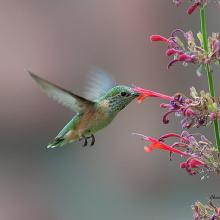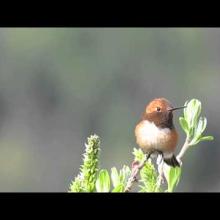

Join BirdNote tomorrow, November 30th!
Illustrator David Sibley and actor H. Jon Benjamin will face off in the bird illustration battle of the century during BirdNote's Year-end Celebration and Auction!
In a garden near the McKenzie River in Oregon’s Cascade Mountains, a downpour pummels the landscape. Imagine a Rufous Hummingbird, like this male, out and about, extracting nectar, searching for gnats and aphids. A hummingbird's stamina against the heavy rain is marvelous. Consider this: its body is nine and a half centimeters long; the average raindrop is about four millimeters. That would be like a person 5'8" being pounded by a torrent of raindrops each three inches across. Incredible!
BirdNote®
A Rufous in the Rain
By Chris Peterson
This is BirdNote!
[Heavy rain – and flowing river]
In a garden near where the McKenzie River rushes out of Oregon’s Cascade Mountains, a downpour pummels crimson-flowered currants, salmonberries, red columbine and native rhododendrons.
Evening draws near, and I’ve taken shelter from the deluge. To my surprise, a female Rufous Hummingbird is still out and about, extracting nectar, searching for gnats and aphids. [Bring in wing whir of Rufous Hummingbird] No doubt, she’s feeding two nestlings that await her return to their tiny nest hidden in a Sitka Spruce or Douglas fir. She’ll feed them every half hour for fifteen to twenty days. As night comes on, the feedings must increase. [Wing whir of Rufous Hummingbird + in the rain]
Rufous Hummingbirds migrate mostly from Mexico, arriving in the Pacific Northwest and Alaska, as early as March. By July, as higher elevations warm, they’ll turn south again, to follow a “floral highway” along the Rockies. [Bring in wing whir of Rufous Hummingbird]. This little bird will need to build her own energy reserves for this trip, soon. [Rufous Hummingbird]
I marvel at her stamina against the heavy rain. Think about it – her body is nine and a half centimeters long; the average raindrop is about four millimeters. That would be like a person five foot eight being pounded by a torrent of raindrops each three inches across.
For BirdNote, I’m Mary McCann.
###
Bird sounds provided by The Macaulay Library of Natural Sounds at the Cornell Lab of Ornithology, Ithaca, New York. Wing whirring of Anna’s Hummingbird [6121] recorded by A.A. Allen.
Rain and river sounds (Essentials #12, #20) were recorded by Gordon Hempton and provided courtesy of QuietPlanet.com.
BirdNote’s theme music was composed and played by Nancy Rumbel and John Kessler.
Producer: John Kessler
Executive Producer: Chris Peterson
© 2015 Tune In to Nature.org June 2017 Narrator: Mary McCann
ID# RUHU-10-2013-06-05RUHU-10










